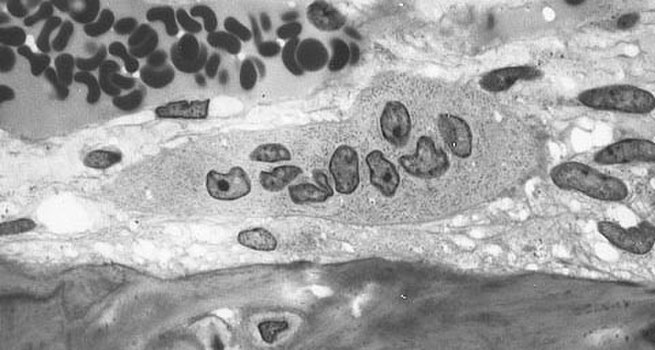
Main Difference
The main difference between Osteoclast and Osteoblast is that the Osteoclast is a type of bone cell that breaks down bone tissue and Osteoblast is a bone-forming cells which secrete an extracellular matrix
-
Osteoclast
An osteoclast (from Ancient Greek ὀστέον (osteon), meaning ‘bone’, and κλαστός (clastos), meaning ‘broken’) is a type of bone cell that breaks down bone tissue. This function is critical in the maintenance, repair, and remodelling of bones of the vertebral skeleton. The osteoclast disassembles and digests the composite of hydrated protein and mineral at a molecular level by secreting acid and a collagenase, a process known as bone resorption. This process also helps regulate the level of blood calcium.
Osteoclasts are found on those surfaces of bone which are undergoing resorption. On such surfaces, the osteoclasts are seen to be located in shallow depressions called resorption bays (Howship’s lacunae). The resorption bays are created by erosive action of osteoclasts on the underlying bone. The border of the lower part of an osteoclast exhibits finger-like processes due to presence of deep infoldings of the plasmalemma; this border is called ruffled border.The ruffled border lies in contact with the bone surface within a resorption bay. The periphery of the ruffled border is surrounded by a ring-like zone of cytoplasm which is devoid of cell organelle but is rich in actin filaments. This zone is called clear zone or sealing zone. The actin filaments enable the cell membrane surrounding the sealing zone to be anchored firmly to the bony wall of Howship’s lacunae. In this way a closed subosteoclastic compartment is created between the ruffled border and the bone that is undergoing resorption. The osteoclasts secrete hydrogen ions, collagenase, cathepsin K and hydrolytic enzymes into this compartment. Resorption of bone matrix by the osteoclasts involves two steps: (1) dissolution of inorganic components (minerals), and (2) digestion of organic component of the bone matrix.The osteoclasts pump hydrogen ions into subosteoclastic compartment and thus create an acidic microenvironment, which increases solubility of bone mineral, resulting in the release and re-entry of bone minerals into the cytoplasm of osteoclasts to be delivered to nearby capillaries. After the removal of minerals, collagenase and gelatinase are secreted into the subosteoclastic compartment. These enzymes digest and degrade collagen and other organic components of decalcified bone matrix. The degradation products are phagocytosed by osteoclasts at the ruffled border. Because of their phagocytic properties, osteoclasts are considered to be a component of the mononuclear phagocyte system (MPS). The activity of osteoclasts is controlled by hormones and cytokines. Calcitonin, a hormone of thyroid gland, suppresses the osteoclastic activity. The osteoclasts do not have receptors for parathyroid hormone (PTH). However, PTH stimulates the osteoblasts to secrete the cytokine called osteoclast-stimulating factor, which is a potent stimulator of the osteoclastic activity.An odontoclast (/odon·to·clast/; o-don´to-klast) is an osteoclast associated with absorption of the roots of deciduous teeth.
-
Osteoblast
Osteoblasts (from the Greek combining forms for “bone”, ὀστέο-, osteo- and βλαστάνω, blastanō “germinate”) are cells with a single nucleus that synthesize bone. However, in the process of bone formation, osteoblasts function in groups of connected cells. Individual cells cannot make bone. A group of organized osteoblasts together with the bone made by a unit of cells is usually called the osteon.
Osteoblasts are specialized, terminally differentiated products of mesenchymal stem cells. They synthesize dense, crosslinked collagen and specialized proteins in much smaller quantities, including osteocalcin and osteopontin, which compose the organic matrix of bone.
In organized groups of connected cells, osteoblasts produce hydroxylapatite – the bone mineral, that is deposited in a highly regulated manner, into the organic matrix forming a strong and dense mineralized tissue – the mineralized matrix. The mineralized skeleton is the main support for the bodies of air breathing vertebrates. It is an important store of minerals for physiological homeostasis including both acid-base balance and calcium or phosphate maintenance.
-
Osteoclast (noun)
A large multinuclear cell associated with the resorption of bone.
-
Osteoclast (noun)
An instrument for performing osteoclasis.
-
Osteoblast (noun)
A mononucleate cell from which bone develops.
